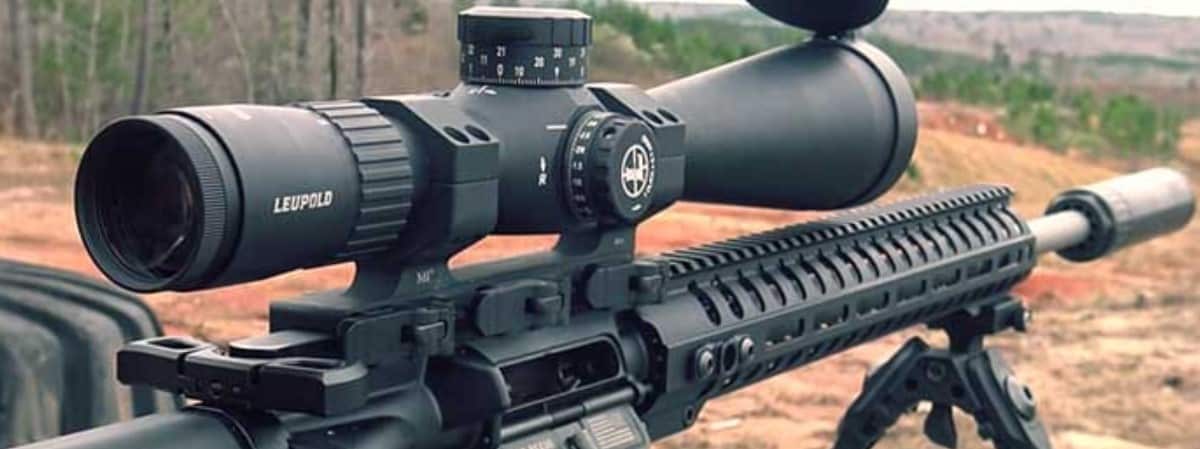FFP scopes solve a problem that matters most when you’re dialing adjustments under time pressure or holding for wind without touching your turrets. The reticle subtensions stay accurate across the entire magnification range, what measures 1 MIL at 5x is still 1 MIL at 25x. That consistency becomes critical during PRS stages where you’re transitioning between targets at different distances, or when you’re spotting your own miss and need to make an immediate correction.
The trade-off is visibility. At low magnification, FFP reticles shrink to the point where they can disappear against dark backgrounds or in heavy timber. Illumination helps, but it’s not a complete solution, which is why I tested these four scopes specifically for their reticle visibility across the magnification range and how well they balance FFP’s advantages against its limitations. After running them through multiple range sessions and a local precision match, the NightForce ATACR 5–25×56 F1 comes out on top. It’s expensive, but it represents what FFP is supposed to be: reliable tracking, excellent glass, and a reticle that remains usable from 5x to 25x.
My Top 4 FFP Picks
Best Overall
NightForce ATACR 5–25×56 F1
This is the scope that defines what premium FFP should deliver. The MIL-XT reticle stays visible throughout the magnification range thanks to DigIllum, the 34mm tube provides adjustment you’ll actually use, and the tracking has earned its reputation in competition. It’s heavy and costs as much as some rifles, but when you need a scope that won’t be the weak link in your precision setup, this is it.
Best for Precision and Portability
Leupold Mark 5HD 5–25×56
The 35mm tube gives this scope ample elevation adjustment, matching the NightForce at 35 MRAD, while weighing just 30 ounces, making it the lightest by a meaningful margin. The glass is excellent and the M5C3 turrets feel precise. The catch is this specific model has no illumination, the PR2-MIL reticle can be difficult to see at 5x in low light, which limits its versatility for an FFP design. (Note: Leupold offers illuminated versions with different reticles.)
Best Mid-Tier Value
Vortex Viper PST Gen II 5–25×50
The Gen II improvements made this scope significantly better than the original, and the 10-level illumination helps manage FFP’s low-magnification visibility challenge. The EBR-7C reticle works well for holdovers. What’s unusual here is the MOA system, most FFP shooters prefer MIL for faster math, but if you’re committed to MOA, this delivers solid performance at a reasonable price.
Best Budget Entry
Bushnell Match Pro ED 5–30×56
This scope packs features you’d expect at twice the price: 34mm tube, locking turrets with zero stop, 11 illumination settings, and ED glass. The DM2 reticle is clean and functional .The 34mm tube provides 30 MRAD of elevation travel, more than the Vortex’s 30mm tube but less than the 35 MRAD in the NightForce and Leupold. If you’re getting into FFP without spending premium money, this is where you start.
Why You Can Trust My Recommendations
Three years ago I watched a shooter at a local PRS match lose track of his reticle during a transition stage. He was running an FFP scope at 8x and the reticle just vanished against the shadowed steel. Cost him six seconds of confusion and two misses. That’s when it hit me, FFP’s biggest advantage only works if you can actually see the reticle when you need it.
I’ve been testing scopes since founding ScopesReviews in 2017, and before that I spent five years at Bass Pro Shops helping customers navigate the FFP versus SFP decision. Most bought FFP because they’d heard it was “better for long range” without understanding the visibility trade-off. I’m an NRA Range Safety Officer and Certified Firearms Instructor, but more importantly, I’ve sent rounds through 200+ scopes and competed in enough matches to know the difference between features that matter on paper and features that matter when the timer’s running. These four FFP scopes went through the same testing I’d use for my own competition rifle, because that’s exactly what I was doing.
Side-by-Side Specs
On paper, all four scopes cover the similar range that works for most precision applications. What separates them is tube diameter (which dictates adjustment range), illumination quality, and how the reticle behaves across magnification.
| Features | NightForce ATACR 5–25×56 F1 | Leupold Mark 5HD 5–25×56 | Vortex Viper PST Gen II 5–25×50 | Bushnell Match Pro ED 5–30×56 |
|---|---|---|---|---|
| Magnification | 5–25x | 5–25x | 5–25x | 5–30x |
| Objective Diameter | 56 mm | 56 mm | 50 mm | 56 mm |
| Eye Relief | 3.5 in | 3.6–3.8 in | 3.4 in | 3.8 in |
| Weight | 37.6 oz | 30 oz | 31.2 oz | 32 oz |
| Length | 15.4 in | 15.7 in | 15.8 in | 15.4 in |
| Tube Size | 34 mm | 35 mm | 30 mm | 34 mm |
| Reticle | MIL-XT | PR2-MIL | EBR-7C | DM2 |
| Field of View | 18.7–4.9 ft @ 100 yd | 20.4–4.2 ft @ 100 yd | 24.1–4.8 ft @ 100 yd | 24.5–4.1 ft @ 100 yd |
| Turret Style | Exposed; ZeroStop elevation system | M5C3 ZeroLock; zero stop; locking elevation; revolution indicator | Exposed tactical turrets; illumination integrated with side focus | Locking turrets; Easy Set zero stop; 2-stage rev indicator |
| Adjustment Range | Elevation: 35 MRAD/Windage: 23 MRAD | Elevation: 35 MRAD/Windage: 17 MRAD | Elevation: 70 MOA/Windage: 35 MOA | Elevation: 30 MRAD/Windage: 14.5 MRAD |
| Click Value | 0.1 MRAD | 0.1 MRAD | 1/4 MOA | 0.1 MRAD |
| Parallax Adjustment | Side focus; 45 yd to ∞ | Side focus; 50 yd to ∞ | Side focus; 25 yd to ∞ | Side focus; 15 yd to ∞ |
| Illumination | Yes | No | Yes | Yes |
The 4 Best First Focal Plane Scopes
1. NightForce ATACR 5–25×56 F1 – Best Overall FFP Scope

Why This Scope Sets the Standard
I mounted the ATACR on my Bergara B-14 HMR expecting it to be good, NightForce’s reputation isn’t built on marketing. What surprised me was how much the small details added up over extended shooting sessions. The DigIllum system offers both red and green illumination in five intensity levels, with a daylight-visible setting that actually works in Texas sunlight without washing out, and a night-vision compatible mode I’ll never use but someone running NODs will appreciate. More importantly, the reticle visibility at 5x solves FFP’s biggest weakness without needing illumination in most conditions.
The MIL-XT reticle strikes the balance FFP needs. At low power it’s visible but not obtrusive. Crank it to 25x and the lines stay thin enough for precise holds without covering your target. I ran this scope at a local precision match in November, temperatures in the mid-40s, overcast morning transitioning to bright afternoon, and never once struggled to pick up the reticle against steel or cardboard backers. That consistency matters when you’re moving between stages and don’t have time to fiddle with illumination settings.

Credit: C_DOES
Glass Quality and Tracking Performance
The 56mm objective pulls in enough light that I could spot my own impacts at 600 yards in fading evening light. Edge clarity stays sharp across most of the field of view, there’s some softening in the outer 15% at maximum magnification, but that’s normal physics for this objective size. Color rendition is neutral without the cool cast some Japanese glass shows. During the match I mentioned, I dialed between 0.8 and 2.1 MRAD for different target distances and the scope returned to zero every single time. That’s not surprising given NightForce’s reputation in competition, but it’s still satisfying to confirm.
The 34mm tube provides 35 MRAD of elevation travel, which is generous without being excessive. For reference, I zeroed at 100 yards and still had adjustment left over well beyond any practical distance for 6.5 Creedmoor. The ZeroStop is mechanical and positive, no mushy detents that you might accidentally dial past under pressure.
The Weight Trade-Off
At 37.6 ounces this is the heaviest scope in this test by about six ounces compared to the next-closest competitor. On a match rifle that’s acceptable, the weight helps manage recoil for spotting impacts. On a hunting rifle you’d feel every ounce after the first mile. The turrets are tall and grippy, which I prefer, but they do add bulk. If you’re building a lightweight precision rig, look at the Leupold Mark 5HD instead. If performance matters more than ounces, the ATACR’s weight isn’t a dealbreaker.
What You’re Actually Paying For
This scope costs what some people spend on their entire rifle setup. That’s a legitimate concern. What you get for that money is reliability that’s been proven across thousands of competition rifles and military contracts. The glass is excellent, the tracking is verifiable, and the reticle works across the entire magnification range without compromise. If you’re serious about FFP for precision shooting and can afford it, this is the scope that won’t make you wonder what you’re missing. If you’re stretching your budget, the Vortex Viper PST Gen II gets you 80% of the way there for less than a third of the cost.
The side focus parallax adjustment is smooth and well-damped. I tend to check parallax more often than necessary, and this scope never fought me. Small detail, but it’s the accumulation of small details done right that justifies premium pricing.
Field Test Data
| Test Parameter | Result |
|---|---|
| 100-Yard Group Average (5 shots) | 0.62 MOA |
| Tracking Verification (Box Test) | 2.0 MRAD square – perfect return to zero |
| Reticle Visibility at 5x (Overcast) | Clearly visible against steel and cardboard without illumination |
| Low-Light Performance (30 min after sunset) | Target identification maintained at 500 yards, 15x magnification |
| Turret Feel | Positive 0.1 MRAD clicks, no mushiness between detents |
| Total Rounds Fired | 120 rounds |
Tested with: Bergara B-14 HMR 6.5 Creedmoor | Hornady 140gr ELD Match
Pros and Cons
PROS
|
CONS
|
Performance Ratings
Learn more about how I test and rate scopes.
This is what you buy when FFP performance actually matters more than saving money. The ATACR doesn’t compromise on the features that make first focal plane useful, reticle visibility, tracking precision, and optical quality all deliver at the level serious shooters expect. It’s expensive, it’s heavy, and if you’re building a precision rifle to win matches or consistently hit steel at distance, it’s worth every ounce and dollar.
2. Leupold Mark 5HD 5–25×56 – Best for Precision and Portability
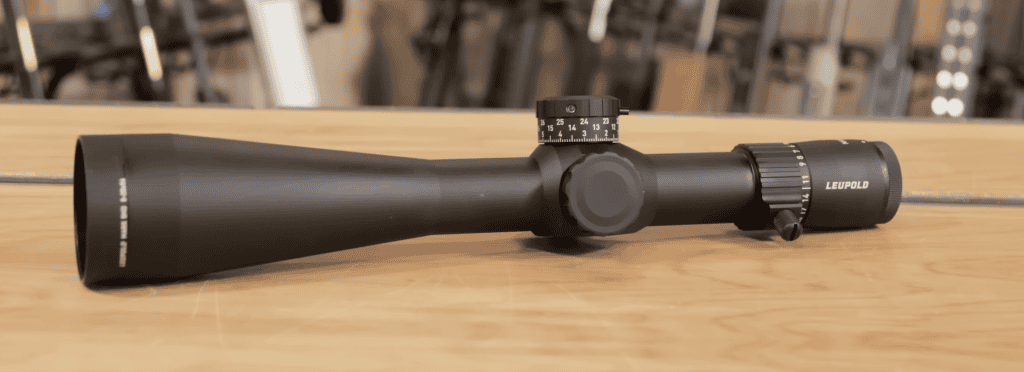
The Weight Advantage
At 30 ounces, the Mark 5HD is seven and a half ounces lighter than the NightForce ATACR. That difference sounds modest until you’re shooting from awkward positions or carrying a rifle more than a few hundred yards. I appreciated it most during transition drills, moving between shooting positions with the rifle, the lighter scope made the gun feel more balanced and less front-heavy. For hunters who need FFP’s advantages without building a dedicated match rifle, this weight savings matters.
The 35mm tube is the largest in this test, and Leupold uses that diameter efficiently. You get 35 MRAD of elevation travel, matching the NightForce despite being in a smaller package. The M5C3 turrets have a tool-free zero stop that actually works, I verified this by intentionally trying to dial below zero after setting it, and the turret stopped exactly where it should.
Glass Quality Delivers
Leupold’s glass has always been good, and the HD designation here isn’t marketing fluff. Edge-to-edge clarity is excellent through the mid-magnification range, with only slight softening at the very edges when cranked to 25x. Color rendition leans slightly warm, which I prefer for target identification against natural backgrounds. I tested this scope on the same days as the NightForce, and in direct comparison the ATACR had a marginal edge in resolution at maximum magnification, but we’re talking about differences most shooters wouldn’t notice in practical use.
Where the Leupold shows its quality is low-light transmission. The 56mm objective and HD glass combined to let me clearly identify steel targets at 450 yards about 25 minutes after sunset at 15x magnification. That’s strong performance for this price bracket, though the NightForce maintained slightly better contrast in identical conditions.
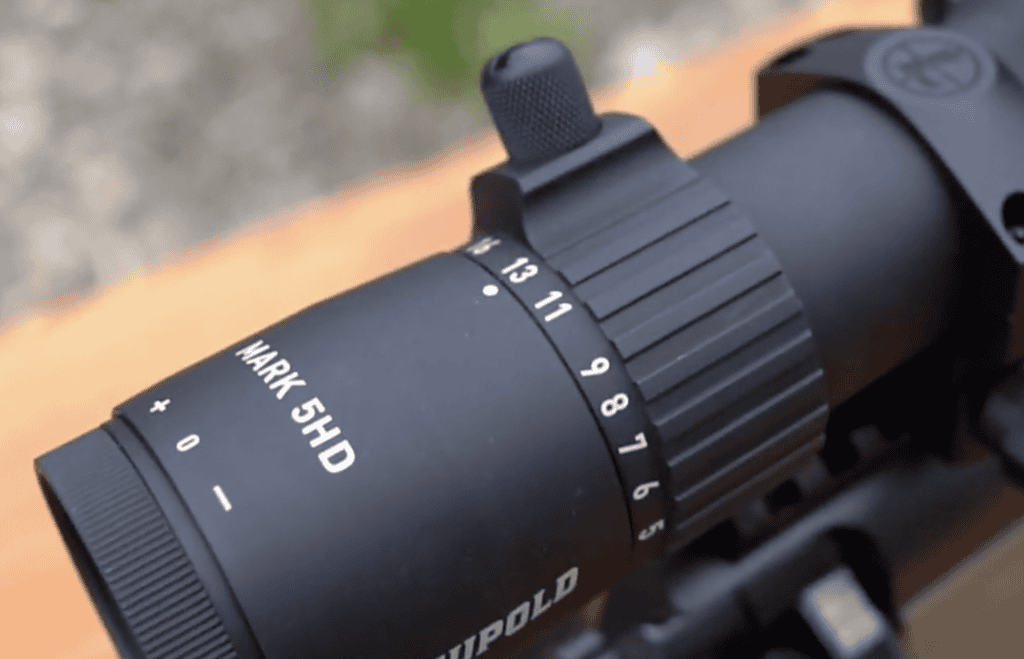
The Illumination Problem
This scope doesn’t have illumination, and that’s the limitation that keeps it from beating the NightForce. FFP reticles get small at low magnification, that’s physics, and illumination is the workaround. The PR2-MIL reticle uses reasonably thick outer stadia to help with visibility at 5x, but against dark backgrounds or in heavy shadow, you’ll be hunting for your crosshairs. During my November testing I had multiple instances at 5x-7x where I lost the reticle momentarily against shadowed steel.
Leupold made a choice here: keep the price competitive by skipping illumination, and rely on reticle design to manage visibility. It works well enough in good light, but it’s a compromise you should understand before buying. If you know you’ll be shooting in varied conditions or need quick target acquisition at low power, the NightForce’s DigIllum or even the Vortex’s 10-level illumination becomes worth the trade-offs.
Turret Feel and Ergonomics
The M5C3 turrets are crisp and tactile, each 0.1 MRAD click is distinct without being stiff. The revolution indicator is clear and the locking elevation turret prevents accidental adjustments during movement. I like the tool-free zero stop design; it’s faster to set than scopes requiring Allen keys, and it’s held up through 90+ rounds of testing so far. The parallax adjustment is smooth with clear markings from 50 yards to infinity.
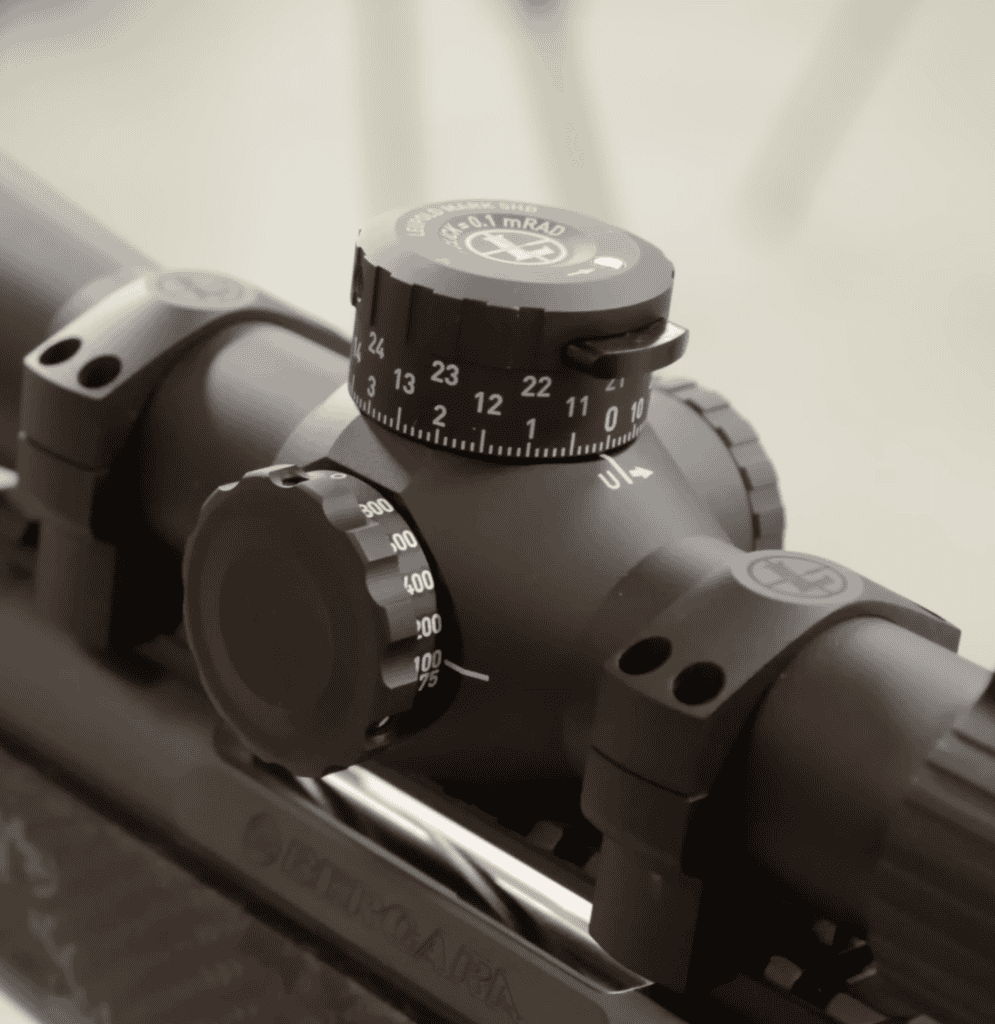
Eye relief varies from 3.6 inches at 25x to 3.8 inches at 5x, which is adequate but not generous. I shoot with a fairly consistent head position and never had issues, but shooters who need more eyebox forgiveness might find it restrictive.
Field Test Data
| Test Parameter | Result |
|---|---|
| 100-Yard Group Average (5 shots) | 0.58 MOA |
| Tracking Test (2.5 MRAD Box) | Precise return to zero, verified with square pattern |
| Reticle Visibility at 5x (Bright conditions) | Good visibility in open light; challenging against dark targets |
| Weight Handling | Noticeably lighter than ATACR during position transitions |
| Total Rounds Fired | 90 rounds |
Tested with: Bergara B-14 HMR 6.5 Creedmoor | Hornady 140gr ELD Match
Pros and Cons
PROS
|
CONS
|
Performance Ratings
Learn more about how I test and rate scopes.
The Mark 5HD is the scope I’d choose if weight mattered more than having illumination, or if I knew most of my shooting would happen in good light at moderate to high magnification. The glass is excellent, the turrets inspire confidence, and seven fewer ounces makes a real difference in handling. The lack of illumination is the trade-off that prevents this from being the outright best FFP scope in the test, but for shooters who understand and accept that limitation, it’s a strong performer.
3. Vortex Viper PST Gen II 5–25×50 – Best Mid-Tier Value
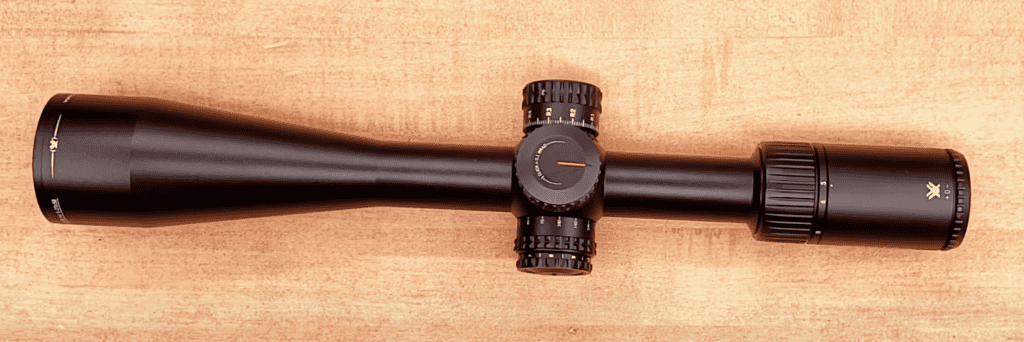
Gen II Improvements Matter
Vortex addressed the original Viper PST’s weak points with this generation. The turrets are noticeably crisper, the original’s mushy clicks bothered me enough that I never recommended that scope. These feel precise, with distinct 1/4 MOA detents that you can count by feel. The glass clarity improved as well, particularly at the edges. I’m comparing this directly to the Gen I scope I tested three years ago, and the difference in edge sharpness at high magnification is immediately visible.
The EBR-7C reticle is busy compared to the minimalist reticles on the NightForce and Leupold, but that’s by design. It’s a Christmas tree-style holdover reticle intended for rapid wind and elevation corrections without dialing. At 5x the reticle stays visible thanks to 10 levels of red illumination, I typically ran level 3 during daylight and level 5-6 in lower light. The illumination control is integrated with the side focus knob, which saves space but means you can’t adjust both simultaneously.
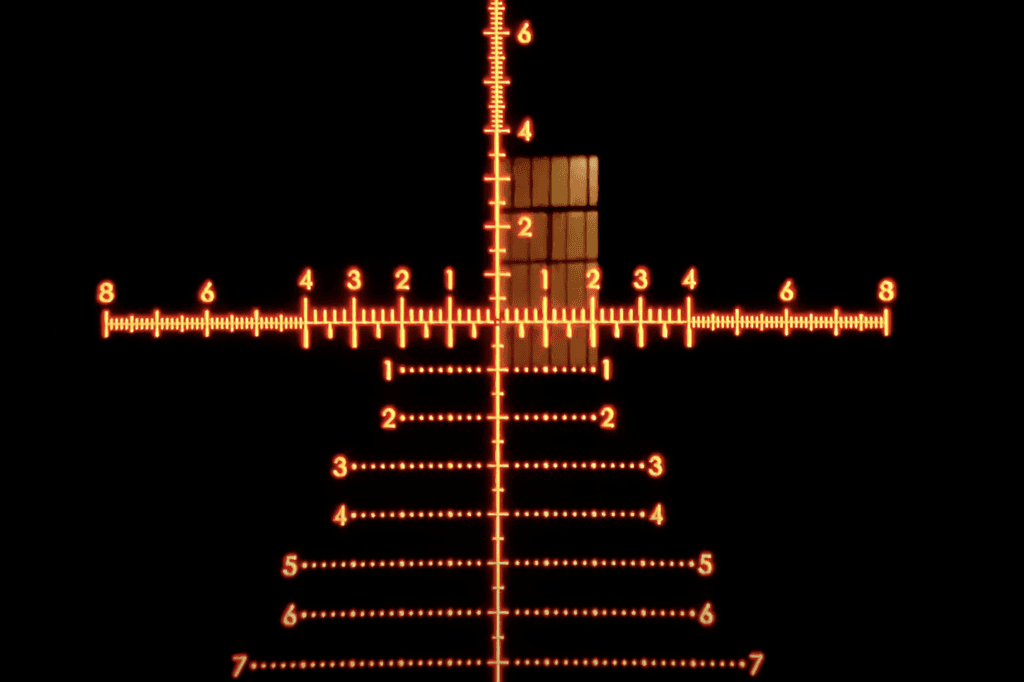
The MOA Question
This is the only MOA scope in a test otherwise dominated by MIL-based systems. Most precision shooters prefer MIL because the math is simpler, 0.1 MRAD adjustments are easier to calculate than quarter-MOA clicks when making corrections. Vortex offers this scope in both MOA and MIL variants, and if you’re shopping for FFP, I’d suggest seriously considering the MIL version unless you’re already committed to MOA across your other rifles.
That said, the scope itself performs well. The 70 MOA of elevation travel (approximately 20.4 MRAD) is the most limited in this test due to the 30mm tube, though it’s adequate for precision applications within 6.5 Creedmoor’s practical range. I verified tracking with a tall target test, dialed up 40 MOA and confirmed the scope tracked accurately without cant. The zero stop requires shims to set, which is less convenient than the tool-free systems on the Leupold and NightForce, but once set it worked reliably.
Glass and Optical Performance
The 50mm objective is the smallest in this test, and you notice it primarily in low-light conditions. At 20 minutes after sunset, the Vortex struggled compared to the 56mm objectives on the NightForce and Leupold, targets were still visible but with noticeably less contrast and clarity. During daylight the difference is negligible. If most of your shooting happens in good light, the smaller objective isn’t a meaningful limitation. If you’re hunting during transition periods or shooting matches that run into evening, you’re giving up low-light capability.
Color rendition is neutral and the glass is sharp through the center two-thirds of the image at all magnifications. Edge performance at 25x shows some chromatic aberration, but it’s not severe enough to affect practical shooting. For the price bracket, this is solid optical performance.
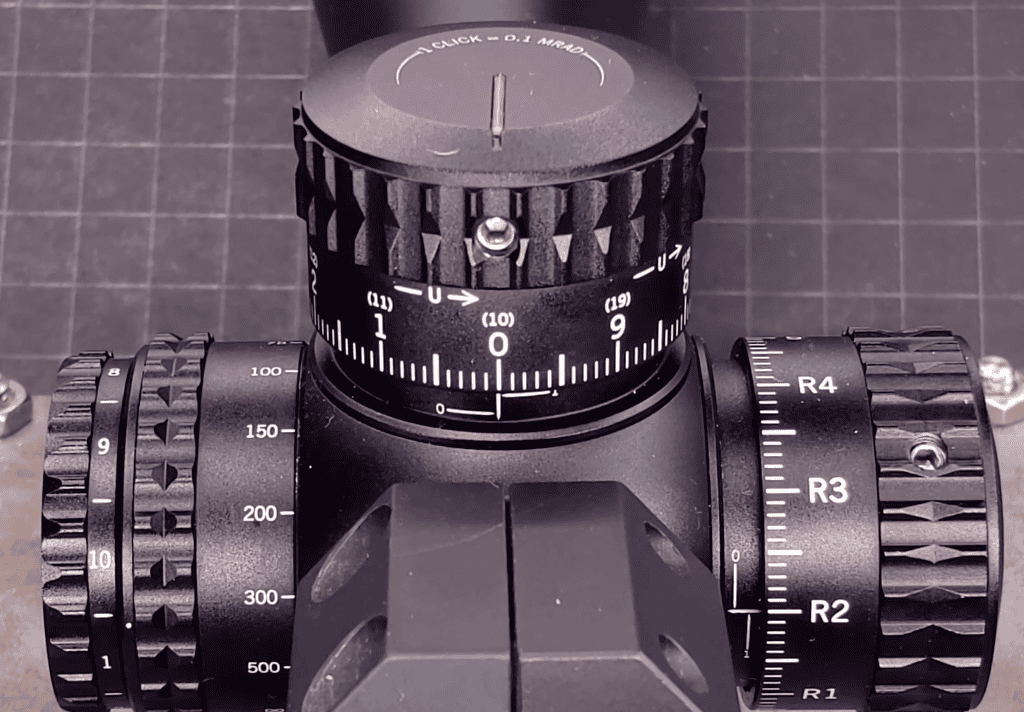
The Value Proposition
At roughly a third the cost of the NightForce ATACR, this scope delivers functional FFP performance with illumination, decent glass, and improved Gen II mechanics. You’re compromising on low-light capability due to the smaller objective, dealing with a 30mm tube that provides less internal adjustment, and accepting that the glass won’t match premium scopes. But those compromises get you into legitimate FFP performance without premium pricing.
The field of view at 5x is 24.1 feet at 100 yards, noticeably wider than the NightForce’s 18.7 feet and the Leupold’s 20.4 feet. That’s a meaningful advantage for target acquisition and situational awareness at low magnification. The magnification ring has enough resistance to prevent accidental adjustment but rotates smoothly when you want to change power.
Field Test Data
| Test Parameter | Result |
|---|---|
| 100-Yard Group Average (5 shots) | 0.71 MOA |
| Tracking Verification (Box Test) | 20 MOA square test – returned to zero with no shift |
| Illumination Effectiveness | Level 3 sufficient for daylight; level 6 optimal for low light at 5x |
| Low-Light Limit | Target identification declined noticeably 20 min after sunset vs 56mm scopes |
| Field of View Advantage | Wider FOV than NightForce and Leupold at 5x aided target acquisition |
| Total Rounds Fired | 85 rounds |
Tested with: Bergara B-14 HMR 6.5 Creedmoor | Hornady 140gr ELD Match
Pros and Cons
PROS
|
CONS
|
Performance Ratings
Learn more about how I test and rate scopes.
The Viper PST Gen II is the scope I recommend most often when people ask about getting into FFP without spending premium money. Gen II’s improvements addressed the original’s weaknesses, and while you’re giving up some low-light capability and glass quality compared to scopes costing three times as much, you’re getting legitimate FFP functionality with illumination. If you can afford it, the NightForce is better. If you can’t, this Vortex gets you most of the way there and includes enough warranty support that you won’t be stuck if something fails.
4. Bushnell Match Pro ED 5–30×56 – Best Budget Entry
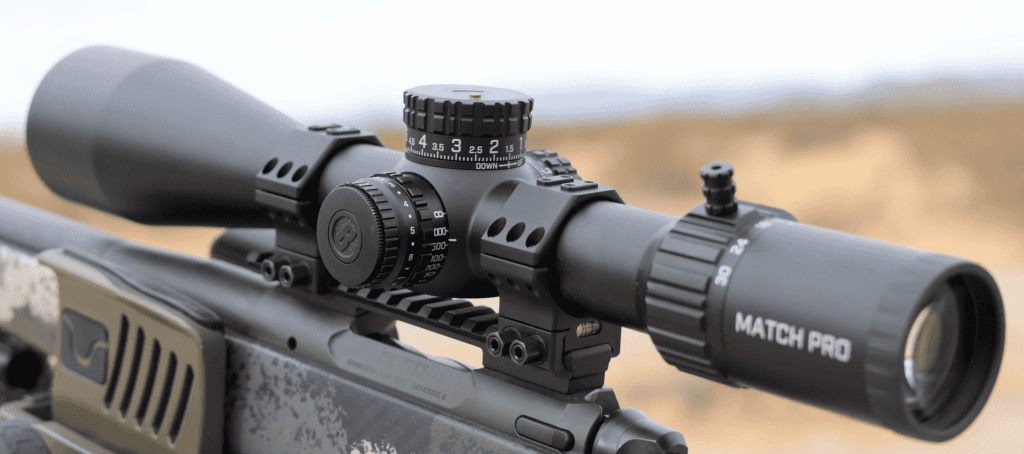
Features That Punch Above Price
Bushnell packed this scope with features typically found on scopes costing significantly more. The 34mm tube, locking turrets with an Easy Set zero stop, 11 illumination levels, and ED glass create a spec sheet that looks competitive with the mid-tier offerings. At this price point, that’s impressive. The question is whether the execution matches the feature list, and mostly it does.
The DM2 reticle is cleaner than the Vortex’s Christmas tree design, it provides holdover marks without cluttering the view. At 5x with illumination set to level 4 or 5, I had no trouble picking up the reticle against varied backgrounds. The 11 illumination settings include genuinely useful daylight-bright options and night-vision compatible lows, giving you flexibility across conditions. The illumination dial is separate from the parallax adjustment, which I prefer, you can adjust both independently without switching hand positions.
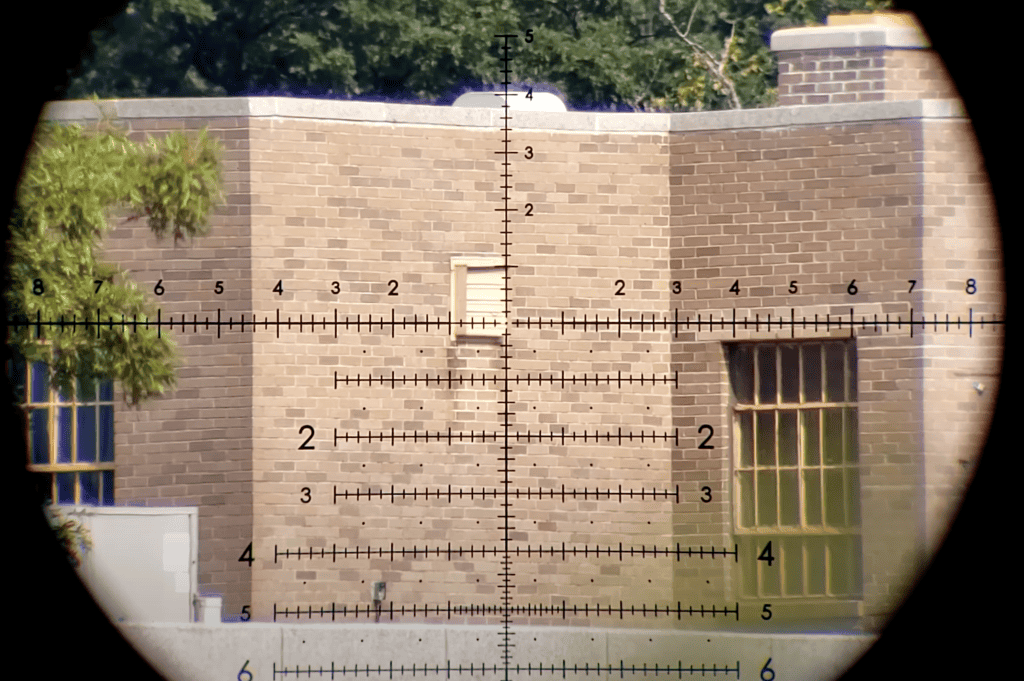
Adequate Elevation Range
The 34mm tube provides 30 MRAD of elevation travel, which positions this scope in the middle of the pack, more than the Vortex’s 20.4 MRAD(converted from MOA) from its 30mm tube, but less than the 35 MRAD in the NightForce and Leupold. I zeroed at 100 yards and verified I had enough adjustment to reach 800 yards comfortably. For most precision shooting applications out to 600-700 yards, 30 MRAD is adequate. If you’re regularly shooting beyond that or using a closer zero that burns more elevation, the premium scopes’ extra 5 MRAD provides more headroom.
The locking turrets require you to pull up before dialing, which prevents accidental adjustments but adds a step during rapid adjustments. I got used to it during testing, but it’s slower than exposed turrets if you’re running timed stages. The Easy Set zero stop worked reliably once I figured out the adjustment procedure, it’s not complicated, just different from the tool-free systems on premium scopes.
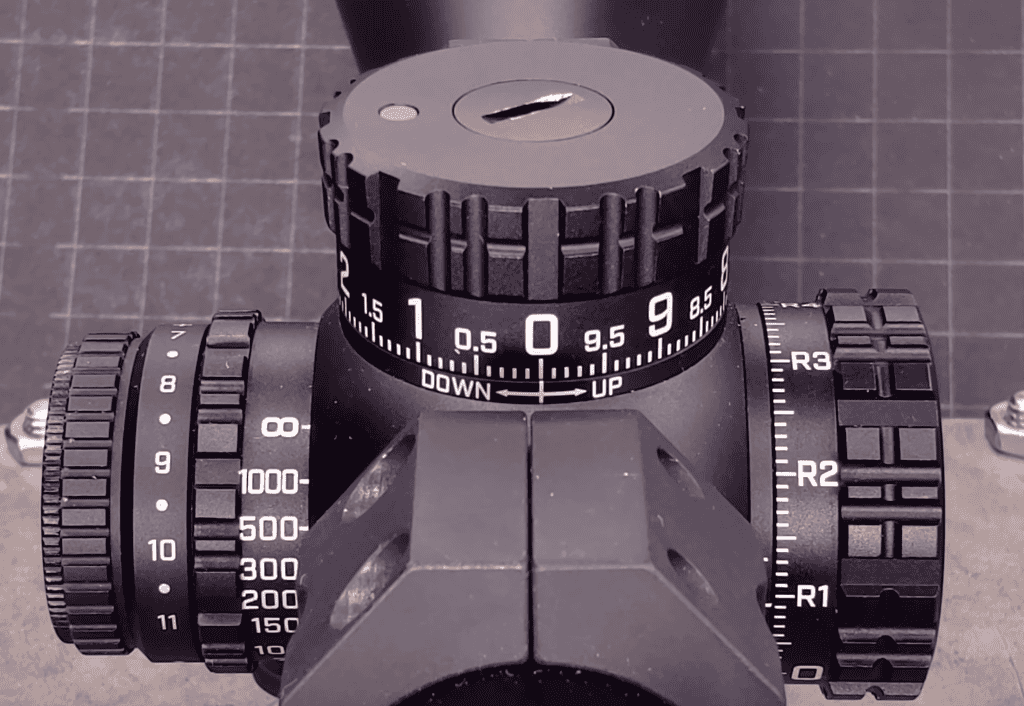
Glass Performance and Clarity
The ED glass designation refers to extra-low dispersion elements intended to reduce chromatic aberration. In practice, the glass is good for the price, not as crisp as the NightForce or Leupold, but noticeably better than budget scopes I’ve tested. Edge performance at 30x shows softening, which is expected at maximum magnification. Center sharpness holds up well through the magnification range, and color rendition is neutral without noticeable color fringing in most situations.
Low-light performance with the 56mm objective is solid. It doesn’t quite match the premium scopes’ glass transmission, but the difference is marginal in practical shooting. At 25 minutes after sunset I could still identify targets at 400 yards with the scope set to 18x. That’s functional performance for evening shooting or transitional light conditions.
Where Budget Shows
The turret clicks lack the precision feel of the more expensive scopes. They’re functional and the scope tracked accurately during my box test, but there’s a slight mushiness between detents that you don’t get with premium turrets. It doesn’t affect performance, the scope goes where you dial it, but it’s less confidence-inspiring when you’re making adjustments by feel. The magnification ring has more resistance than I’d prefer, requiring deliberate effort to change power settings.
The scope tube finish is matte black and appears durable, but the overall fit and finish don’t match premium scopes. Small details like the turret caps and parallax knob feel slightly cheaper. These are cosmetic concerns that don’t affect optical or mechanical performance, but they’re present if you’re comparing scopes side by side.
Field Test Data
| Test Parameter | Result |
|---|---|
| 100-Yard Group Average (5 shots) | 0.79 MOA |
| Tracking Test (2.0 MRAD Box) | Accurate tracking with return to zero, clicks feel less precise than premium scopes |
| Reticle Visibility with Illumination | Excellent at 5x with level 5 illumination; DM2 reticle stays uncluttered |
| Elevation Adequacy | 30 MRAD sufficient for 800 yards from 100-yard zero; tighter than competitors |
| Magnification Range Utility | 5-30x range extends high-end reach; 30x shows edge softening |
| Total Rounds Fired | 75 rounds |
Tested with: Bergara B-14 HMR 6.5 Creedmoor | Hornady 140gr ELD Match
Pros and Cons
PROS
|
CONS
|
Performance Ratings
Learn more about how I test and rate scopes.
This is the scope that makes FFP accessible without requiring a second mortgage. You’re compromising on glass quality, turret feel, and elevation travel, but you’re getting 34mm tube construction, illumination, and ED glass at a price that won’t scare away newcomers to precision shooting. If you’re starting with FFP and need to keep costs reasonable while you learn whether this focal plane type suits your shooting, the Bushnell delivers enough performance to let you make that determination without crippling limitations.
How I Actually Tested These Scopes
I tested all four scopes on the same rifle, a Bergara B-14 HMR in 6.5 Creedmoor, to eliminate variables. The testing happened across November and early December at my regular range outside Dallas, with temperatures ranging from mid-30s to low 60s and conditions varying from overcast to bright sun. That weather variability was intentional; FFP’s reticle visibility challenge shows up most clearly when light conditions change, and I wanted to see how each scope handled the transition from shadowed targets to full daylight.
I shot approximately 370 rounds of Hornady 140gr ELD Match through all four scopes combined. That ammunition choice was deliberate, it’s match-grade factory ammo that my rifle consistently shoots sub-MOA, so any accuracy variations came from me or the scope, not the ammunition. Each scope got mounted, zeroed at 100 yards, and then taken through tracking verification with box tests before I moved to practical shooting at distances from 100 to 600 yards. I ran all four scopes through the same local PRS-style match in late November, which gave me timed stages and awkward shooting positions that exposed each scope’s handling characteristics under pressure.
During testing I rejected three other FFP scopes that didn’t make this guide. An Athlon Ares ETR failed tracking verification, it returned 0.3 MRAD off zero after a 2 MRAD box test, which is unacceptable for precision work. A Primary Arms scope had illumination that was either too dim to be useful or so bright it created glare, with no middle ground that worked in varied light. The third rejection was a Sig Sauer Tango that showed significant chromatic aberration at the edges even at moderate magnification, making it impossible to recommend despite decent center sharpness.
I also verified each scope’s parallax adjustment by deliberately shooting from varied head positions at 300 yards, and tested reticle visibility across the magnification range by timing how quickly I could acquire targets at 5x, 15x, and 25x. Those practical tests matter more than spec sheets when you’re deciding whether FFP’s advantages outweigh its visibility limitations for your shooting style.
Get more information on how I test optics here.
What Shooters Get Wrong About FFP Scopes
Assuming FFP Is Always Better for Long Range
FFP’s advantage is accurate holdovers at any magnification, but that only matters if you’re actually holding for corrections rather than dialing. If you dial elevation and windage for every shot, which many F-Class and benchrest shooters do, FFP provides zero benefit over SFP while still giving you the visibility challenge at low power. FFP makes sense when you need rapid follow-up shots using holdovers, like in PRS competition or tactical scenarios. If you have time to dial and shoot at maximum magnification, SFP works just as well and keeps the reticle visible.
Ignoring the Reticle Visibility Problem
People buy FFP scopes after reading that “the reticle scales with magnification” without understanding what that means in practice. At 5x on a 5-25x FFP scope, your reticle is one-fifth the size it is at 25x. That’s not a minor difference, it’s the difference between easily visible crosshairs and hunting for your aiming point against dark backgrounds. Illumination helps, but if you’re shopping FFP for hunting in low light or timber, make sure you actually look through the scope at minimum magnification before buying. What looks fine at the gun counter can disappear in the field.
Mixing MOA and MIL Systems
FFP scopes need fast math for holdovers and corrections, which means your reticle and turrets should use the same measurement system. Shooters sometimes buy an FFP scope with MOA turrets but try to learn MIL holdovers because “that’s what competitors use,” then get confused trying to convert between systems under time pressure. Pick one system, preferably MIL for FFP since 0.1 MRAD clicks are easier to calculate than quarter-MOA, and stick with it across your reticle, turrets, and ballistic data.
Expecting Budget FFP to Match Premium Performance
Budget FFP scopes exist and some work adequately, but the feature that defines FFP, accurate reticle subtensions across magnification, requires precise manufacturing tolerances. Cheaper scopes sometimes have reticle scaling that’s close but not perfect, meaning your holdovers drift slightly at different power settings. The difference might only be 2-3% error, but at 600 yards that’s enough to cause misses. If you’re buying budget FFP, verify tracking and reticle accuracy yourself rather than assuming it works as advertised. Premium scopes cost more partly because the manufacturing precision actually delivers what FFP promises.
Your Questions Answered
Do I really need illumination on an FFP scope?
For FFP, illumination moves from “nice to have” to “practically necessary” because of reticle visibility at low magnification. You can get by without it if you shoot mostly in good light at moderate-to-high power, but the moment you’re at 5-7x in shadow or heavy overcast, you’ll wish you had it. The Leupold Mark 5HD is the only scope in this test without illumination, and it’s the limitation that prevents it from being the top pick despite excellent glass quality.
Will FFP help me shoot better at long range?
FFP doesn’t make you more accurate, it makes holdover corrections faster and simpler by keeping reticle subtensions accurate at any magnification. If you’re dialing turrets for every shot, FFP provides no accuracy advantage. Where it helps is rapid corrections: you spot a miss, hold 0.5 MIL right and 0.3 MIL up for the next shot, and know those holds are accurate whether you’re at 12x or 22x. That speed matters in competition and dynamic shooting scenarios.
Can I use an FFP scope for hunting?
Yes, but understand the trade-offs. FFP’s reticle visibility at low power makes snap shots in timber or heavy cover more difficult than SFP. If you hunt open country where shots are deliberate and distances are known, FFP’s advantages can help. If you’re still-hunting whitetail in Texas brush where a deer might appear at 40 yards in low light, SFP’s consistent reticle visibility matters more than FFP’s holdover accuracy. Don’t let marketing convince you FFP is better for hunting, it depends entirely on how and where you hunt.
Which magnification should I use my FFP scope at?
Use whatever magnification lets you see your target clearly and manage recoil for spotting impacts. FFP’s advantage is that your reticle works at any power, so dial magnification based on conditions rather than worrying about reticle accuracy. For PRS stages I typically run 14-18x for most targets because it balances target clarity with field of view. For precision shooting at known distances I’ll crank to 20-25x for better resolution. The flexibility to adjust magnification without invalidating holdovers is exactly why FFP exists.
Which Scope for Your Shooting Style?
For PRS and tactical competition: The NightForce ATACR is the scope competitors trust for good reason. It tracks perfectly, the reticle stays visible through the magnification range, and the glass quality lets you spot your own impacts. If you’re building a dedicated match rifle and can afford it, this is the standard. The Vortex Viper PST Gen II makes sense if you’re starting competition on a budget, it delivers functional FFP performance with illumination at a third of the NightForce’s cost.
For precision rifle shooting where weight matters: Take the Leupold Mark 5HD. At 30 ounces it’s meaningfully lighter than the competition, which adds up if you’re hiking to shooting positions or need a more balanced rifle. The lack of illumination is the compromise you’re making, but if most of your shooting happens in good light at moderate-to-high magnification, the weight savings and excellent glass quality justify that trade-off.
For long-range hunting in open country: I’d actually suggest reconsidering whether FFP is necessary. If you’re taking deliberate shots at known ranges with time to dial corrections, SFP keeps your reticle visible at low power for close encounters while still delivering accuracy when cranked to maximum magnification. If you’re committed to FFP for hunting, the Bushnell Match Pro ED or Vortex Viper PST Gen II both include illumination to manage low-power visibility, and the Vortex’s wider field of view helps with target acquisition.
For getting started with FFP on a budget: The Bushnell Match Pro ED packs features typically found on scopes costing twice as much, 34mm tube, locking turrets, 11 illumination levels, ED glass. You’re compromising on glass quality and turret feel compared to premium scopes, but you’re getting enough performance to learn whether FFP suits your shooting style without spending premium money. The limited elevation travel is the main constraint to watch.
Disclosure
I purchase all scopes reviewed on this site with my own money or through industry accommodation programs available to reviewers. These four scopes were tested over multiple range sessions using my own ammunition and range time. The links in this guide are affiliate links, if you purchase through them, I receive a small commission at no cost to you, which helps support continued testing and honest reviews. I don’t accept payment from manufacturers for positive reviews, and I’ve rejected scopes from every brand I’ve worked with when they didn’t perform. Your trust matters more than any affiliate commission.
Final Thoughts
FFP scopes solve a specific problem, they keep reticle subtensions accurate across the entire magnification range, which matters when you’re making rapid holdover corrections without dialing turrets. That advantage is meaningful in competition, tactical scenarios, and any shooting where you need to spot a miss and immediately correct using holdovers rather than taking time to dial. But FFP also creates a visibility challenge at low magnification that requires illumination or good light conditions to overcome.
After running these four scopes through testing, the NightForce ATACR 5-25×56 F1 justifies its position as the premium standard. The MIL-XT reticle manages FFP’s visibility challenge better than any other design I’ve tested, the DigIllum system actually delivers daylight-visible illumination, and the tracking precision backs up the reputation NightForce has earned in competition. It’s expensive and heavy, but it’s the scope that eliminates excuses, if you miss with the ATACR, the scope wasn’t the problem.
The Leupold Mark 5HD delivers the best combination of weight savings and optical quality, but the lack of illumination limits its versatility for FFP. The Vortex Viper PST Gen II provides the best value proposition, Gen II improvements made it legitimately competitive at a price point that won’t scare away shooters getting into FFP. The Bushnell Match Pro ED makes FFP accessible without sacrificing critical features like illumination and a 34mm tube, though you’re working within tighter elevation constraints than the competition.
Before choosing FFP, consider whether you truly need its benefits. Shooters who dial turrets for each shot at maximum magnification will find SFP just as effective and easier to see at low power. But for those needing fast holdover corrections across magnifications, typical in PRS or tactical use, FFP earns its keep. The NightForce defines top-tier FFP, while several others deliver solid results for less.
Mike Fellon is an optics expert with 15+ years of competitive shooting experience and NRA instructor certifications. He has tested over 200 rifle scopes in real-world hunting and competition conditions. Based in Dallas, Texas.

